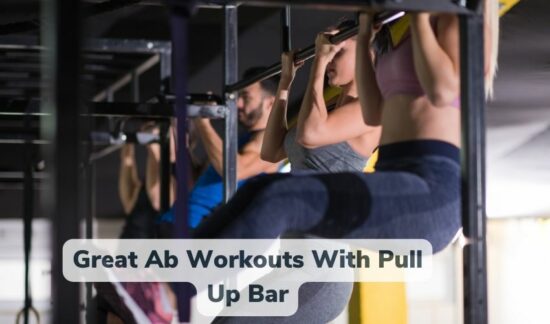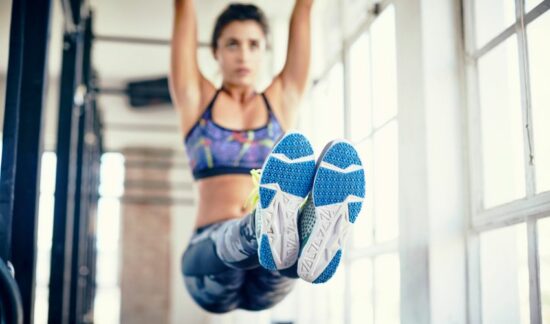Incorporating a pull-up bar into your ab workouts can provide numerous benefits and take your core training to the next level. In this comprehensive guide, we will explore various exercises and techniques that utilize a pull-up bar to target your abdominal muscles effectively. Whether you’re a beginner or an experienced fitness enthusiast, this article will provide you with valuable insights and instructions to enhance your ab workout routine.
Understanding the Importance of Strong Abdominal Muscles
Strong abdominal muscles play a crucial role in overall core strength and stability. The core acts as a stabilizer for the entire body and is involved in almost every movement we make. By developing strong abs, you can improve your posture, enhance athletic performance, and reduce the risk of injuries.

Benefits of Ab Workouts With Pull Up Bar
Ab workouts with a pull-up bar offer several benefits for your core strength and overall fitness. Here are some of the key advantages:
- Core Strengthening: Pull-up bar ab workouts engage your core muscles effectively. Exercises such as hanging leg raises, knee raises, and windshield wipers target your abdominal muscles, including the rectus abdominis, obliques, and transverse abdominis. These exercises challenge your core stability and help develop a strong and well-defined midsection.
- Functional Strength: Pull-up bar ab exercises promote functional strength by simulating real-life movements. A strong core is crucial for activities like lifting objects, twisting, bending, and maintaining proper posture. By strengthening your abs on the pull-up bar, you improve your ability to perform these movements efficiently and with reduced risk of injury.
- Upper Body Engagement: Many ab exercises performed on a pull-up bar involve holding your bodyweight, which also engages your upper body muscles. Exercises like hanging knee raises or toes-to-bar require grip strength, forearm engagement, and activation of the back and shoulder muscles. This provides a comprehensive workout for multiple muscle groups simultaneously.
- Scalability and Variety: The pull-up bar offers a wide range of ab exercises that can be modified to suit your fitness level. Whether you’re a beginner or advanced athlete, you can adjust the difficulty by altering the exercise technique, range of motion, or adding weights. This scalability ensures that you can continuously challenge your core muscles and progress over time.
- Convenience and Accessibility: Pull-up bars are relatively inexpensive and can be installed in various locations, such as doorframes or mounted on walls or ceilings. This makes them easily accessible for home workouts or in gyms. With a pull-up bar, you have a dedicated space for ab exercises that doesn’t require extensive equipment or gym memberships.
- Core Stability and Posture Improvement: Ab workouts with a pull-up bar enhance your core stability and improve your posture. Strengthening your core muscles helps maintain proper alignment and reduces the risk of lower back pain. By developing a strong core, you support the spine and promote better posture in both daily activities and other exercises.
Remember to consult with a fitness professional or trainer to ensure you perform exercises correctly and avoid any potential injuries. It’s also essential to listen to your body, progress gradually, and incorporate a well-rounded fitness routine that includes cardiovascular exercises, strength training, and flexibility work.
Choosing the Right Pull-Up Bar for Ab Workouts
Before diving into ab exercises, it’s essential to select the right pull-up bar that suits your needs and space. There are various types of pull-up bars available in the market, such as doorway bars, wall-mounted bars, and free-standing bars. Consider factors like stability, weight capacity, and adjustability when making your choice.
Proper Grip and Hand Placement on the Pull-Up Bar
To ensure effective ab exercises with a pull-up bar, it’s crucial to have a secure and comfortable grip. Experiment with different grip techniques, such as overhand grip, underhand grip, or a combination of both. Hand placement variations, such as wide grip, close grip, or neutral grip, can target different areas of the abs and add variety to your workouts.
Pull-Up Bar Leg Raises

Leg raises are an excellent exercise for targeting the lower abs, hip flexors, and obliques. With step-by-step instructions, you can perform leg raises on a pull-up bar effectively. Start with hanging leg raises, gradually progressing to straight leg raises and eventually incorporating knee tucks or toe-to-bar raises to intensify the exercise.
Hanging Knee Raises
Hanging knee raises are another fantastic exercise for engaging the lower abs, hip flexors, and obliques. Learn the proper form and technique to execute hanging knee raises correctly. Focus on controlling the movement, lifting your knees toward your chest while maintaining a stable upper body position.
L-sit Hold on the Pull-Up Bar
The L-sit hold is a challenging exercise that activates the entire core, including the abs and hip flexors. Mastering this exercise requires core strength and body control. Start with bent knees and progress to a full L-sit hold, where your legs are extended parallel to the ground. Utilize various progressions, such as L-sit holds with one leg extended or L-sit pull-ups, to increase the challenge.
Russian Twists with a Pull-Up Bar
Russian twists are effective for targeting the obliques and rectus abdominis. By incorporating a pull-up bar, you can add an extra dimension of intensity to this exercise. Perform Russian twists while holding the pull-up bar, twisting your torso from side to side. Experiment with different hand placements, such as wide grip or neutral grip, to vary the intensity.
Scissor Kicks on the Pull-Up Bar
Scissor kicks are a dynamic exercise that engages the lower abs and hip flexors. With the pull-up bar, you can perform scissor kicks while hanging, focusing on maintaining stability and avoiding swinging motions. Initiate the movement by raising one leg while lowering the other, alternating the leg position in a scissor-like motion.
Windshield Wipers on the Pull-Up Bar
Windshield wipers are an advanced exercise that targets the obliques and rectus abdominis. Using the pull-up bar, follow a step-by-step guide to perform windshield wipers correctly. Hang from the bar, engage your core, and swing your legs from side to side in a controlled manner. To increase the difficulty, you can try straight-leg windshield wipers or add ankle weights.
Hanging Bicycle Crunches
Hanging bicycle crunches combine the benefits of traditional bicycle crunches with the added challenge of suspension. Hang from the pull-up bar and bring your knees toward your chest while simultaneously twisting your torso to touch your elbows with the opposite knee. This exercise effectively targets the obliques and rectus abdominis.
Dragon Flags on the Pull-Up Bar
Dragon flags are an advanced ab exercise that requires significant core strength and control. Using the pull-up bar, learn the proper setup and execution technique to perform dragon flags effectively. By keeping your body straight and lowering it toward the ground, you engage the rectus abdominis and hip flexors. Start with regressions like bent knee dragon flags and gradually progress to full dragon flags.
Plank Holds with the Pull-Up Bar
Plank holds are excellent for overall core activation, including the abs, obliques, and lower back. By incorporating the pull-up bar, you can introduce variations and challenges to the traditional plank exercise. Utilize different grip options, such as gripping the bar with an overhand grip or using suspension straps, to add instability and engage more muscles.
Hollow Body Holds on the Pull-Up Bar
Hollow body holds are fantastic for improving body control and core strength. With the pull-up bar, you can perform hollow body holds effectively. Hang from the bar, engage your core, and maintain a straight body position with your arms and legs lifted off the ground. Focus on avoiding excessive swinging and strive for stability throughout the exercise.
Knee Tucks on the Pull-Up Bar
Knee tucks target the lower abs, hip flexors, and obliques. Utilizing a pull-up bar, you can perform knee tucks with proper technique and form. Hang from the bar and bring your knees toward your chest, contracting your abs. Gradually increase the difficulty by extending your legs or incorporating controlled swinging motions.
Side-to-Side Knee Raises on the Pull-Up Bar
Side-to-side knee raises effectively engage the obliques, hip flexors, and lower abs. Learn the step-by-step instructions to perform this exercise on a pull-up bar. While hanging, raise your knees to one side, then lower them and raise them to the other side in a controlled motion. Maintain control and focus on achieving a full range of motion.
Jackknife Sit-Ups with a Pull-Up Bar
Jackknife sit-ups can be intensified by incorporating a pull-up bar. Follow the execution technique to perform jackknife sit-ups effectively, targeting the rectus abdominis and hip flexors. Start with a bent knee position and gradually progress to full jackknife sit-ups. Explore modifications and progressions to cater to different fitness levels.
Advanced Ab Exercises with a Pull-Up Bar
For those seeking advanced challenges, there are various ab exercises that can be performed on a pull-up bar. Examples include front levers, muscle-ups, and hanging windshield wipers. While these exercises require significant strength and skill, they provide exceptional benefits for the abs and core. Approach advanced exercises gradually, focusing on proper form and progression.
Incorporating Ab Workouts with a Pull-Up Bar into Your Fitness Routine
To maximize the benefits of ab workouts with a pull-up bar, it’s essential to integrate them into your existing fitness routine. Learn valuable tips for incorporating ab exercises effectively, including frequency and duration recommendations. Remember to prioritize rest and recovery to allow your muscles to grow and develop.
Common Mistakes to Avoid
Identifying and avoiding common mistakes can help you optimize your ab workouts with a pull-up bar. Learn about potential errors in form or technique and discover tips to correct them. By maintaining proper form and avoiding injury-prone movements, you can make the most out of your ab training sessions.
Conclusion
In conclusion, ab workouts with a pull-up bar offer a versatile and effective way to target your abdominal muscles. By following the exercises and techniques outlined in this article, you can strengthen your abs, improve core stability, and enhance your overall fitness level. Embrace the challenge, try different exercises, and progress gradually to achieve optimal results. Remember, incorporating ab training into a well-rounded fitness routine is key to achieving a strong and balanced physique.
FAQs
Because the abdominal muscles are employed in both pushing and pulling activities, they can be exercised multiple times each week; however, each training session should focus on a distinct set of exercises. You might also try dividing your program for your midsection into separate workouts for your abdominal muscles and your core, performing core strengthening exercises on your pull days and abdominal exercises on your push days.
How Many Pull-Ups Should You Aim to Complete Each Day? In general, you should never perform the same workout on consecutive days when you’re training. Pull-up workouts shouldn’t take up more than two or three of your weekly workout slots at most. Aiming for a number of pull-ups per session that ranges from 15 to 24 is a nice goal to have.